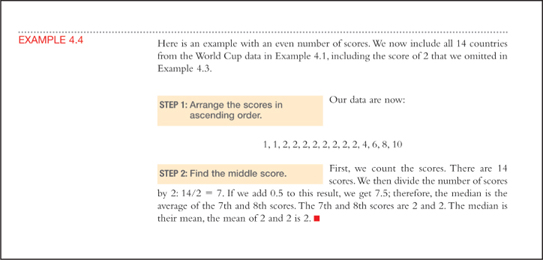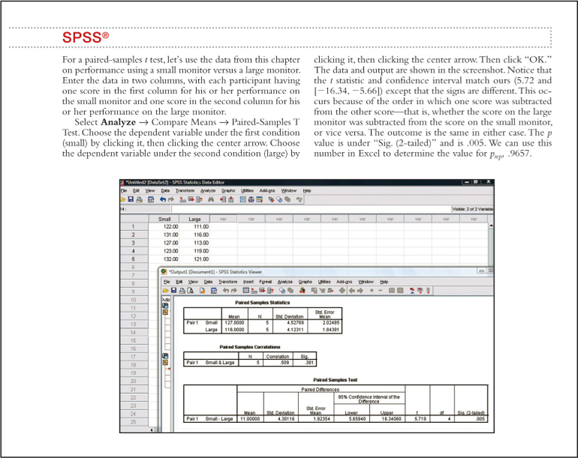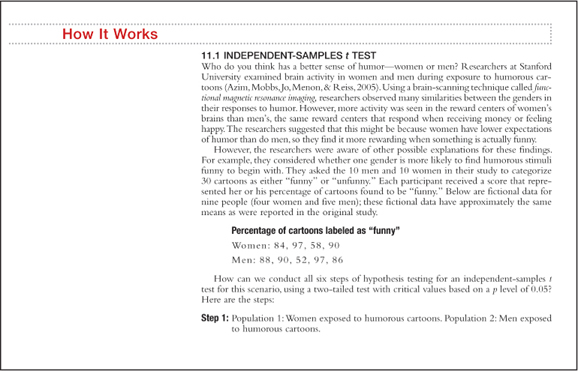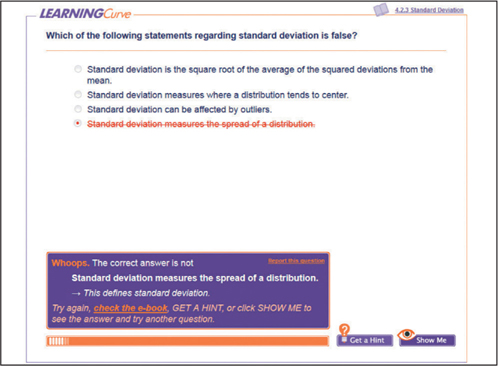Preface
Statistics is hot. According to the New York Times on June 20, 2013, statistics is perhaps the most promising, adventurous career option you can choose right now—
If you dare to embrace what your professor is teaching you, it will bring you to the brink of personal and social change. You will have to make many decisions about how you think—
We dare you to love this course.
Trends in Statistics: What’s Coming Next?
Statistics and statistical reasoning are in the midst of profound changes. Here are three important trends:
Trend 1: Visual Displays of Data. On the one hand, Chapter 3 of this text reminds us that there is nothing very new about creating visual displays of data. On the other hand, the entire field has gone topsy-
Trend 2: Bayesian Statistics. The field of statistics is also moving forward by looking backwards! The story of Thomas Bayes, an obscure clergyman born around 1701, demonstrates that some great ideas just won’t go away. Imagine that a ball is thrown onto a square billiard table and that it comes to rest slightly to the left of center. But the ball is removed before we get to see where it landed—
xii
Trend 3: Free Software. Although earning a college degree is pretty expensive, the Internet has created opportunities for particular forms of education to progressively become less expensive. Massive open online courses (MOOCs) are just one of the more obvious efforts. One of your coauthors, Tom, took one MOOC with 80,000 other classmates. He didn’t actually finish the course because early on, he already had gotten what he wanted out of the course and didn’t need to learn how to write a research paper. Kahn Academy online tutorials are another excellent, low-
What’s New in the Third Edition
In this new edition of Statistics for the Behavioral Sciences, we connect students to statistical concepts as efficiently and memorably as possible. We’ve sharpened the focus of the book on the core concepts and introduce each topic with a vivid, real-
Before You Go On
Each chapter opens with a Before You Go On section that highlights the concepts students need to have mastered before they move on to the next chapter.

xiii
Mastering the Formulas and Mastering the Concepts
Some of the most difficult tasks for students new to statistics are identifying the key points and connecting this new knowledge to what they have covered in previous chapters. The unique Mastering the Formula and Mastering the Concept marginal notes provide students with helpful explanations that identify each formula when it is first introduced and each important concept at its point of relevance. Appendix E, Figure E-1: Choosing the Appropriate Hypothesis Test is a terrific summary that shows students how to apply statistical techniques to their research. It’s the entire text summarized on a single page; students will learn it quickly and use it for the rest of their careers in statistics.

Illustrative, Step-
The text is filled with real-

xiv
SPSS®
For instructors who integrate SPSS into their course, each chapter includes outlined instructions and screenshots of SPSS output to help students master the program using data from the text.

How It Works—
Many students have anxiety as they approach end-

xv
Building Better Graphs Using Excel
A new appendix guides students through the basics of creating a clear, readable graph with Excel. Using an example from the text, students are guided through the steps of creating a graph and then changing Excel’s default choices to meet the criteria for an excellent graph.
Game Design and Practice
Like a computer game that uses repetition and small changes to lift its players to higher levels of achievement, we have designed increasing challenges beginning with confidence-
- Clarifying the Concepts questions help students to master the general concepts, the statistical terminology, and the conceptual assumptions of each topic.
- Calculating the Statistics exercises provide students a way to practice making the basic calculations for each formula and statistic.
- Applying the Concepts exercises apply statistical questions to real-
world situations across the behavioral sciences and require students to bridge their knowledge of concepts and calculations. - Putting It All Together exercises ask students both to apply the concepts from the chapter to a real-
world situation and to connect the chapter’s concepts to ideas from previous chapters.
Media and Supplements
LaunchPad with LearningCurve Quizzing
A comprehensive Web resource for teaching and learning statistics
LaunchPad combines Worth Publishers’ award-
xvi

LaunchPad to Accompany Statistics for the Behavioral Sciences, Third Edition, can be previewed and purchased at www.whfreeman.com/
Statistics for the Behavioral Sciences, Third Edition, and LaunchPad can be ordered together (ISBN-
LaunchPad for Statistics for the Behavioral Sciences, Third Edition, includes all the following resources:
- The LearningCurve quizzing system was designed using the latest findings from learning and memory research. It combines adaptive question selection, immediate and valuable feedback, and a game-
like interface to engage students in a learning experience that is unique to them. Each LearningCurve quiz is fully integrated with other resources in LaunchPad through the Personalized Study Plan, so students can review Worth’s library of videos and activities. State- of- the- art question analysis reports allow instructors to track the progress of individual students as well as their class as a whole. 
xvii
- An interactive e-
Book allows students to highlight, bookmark, and make their own notes, just as they would with a printed textbook. Students can use Google-style searching and take advantage of in- text glossary definitions. - The Statistical Video Series consists of StatClips, StatClips Examples, and Statistically Speaking “Snapshots.” The videos can be used to view animated lecture videos, whiteboard lessons, and documentary-
style footage that illustrate key statistical concepts and help students visualize statistics in real- world scenarios. - StatClips lecture videos, created and presented by Alan Dabney, PhD, Texas A&M University, are innovative visual tutorials that illustrate key statistical concepts. In 3 to 5 minutes, each StatClips video combines dynamic animation, data sets, and interesting scenarios to help students understand the concepts in an introductory statistics course.
- In StatClips Examples, Alan Dabney walks students through step-
by- step examples related to the StatClips lecture videos to reinforce the concepts through problem solving. - SnapShots videos are abbreviated, student-
friendly versions of the Statistically Speaking video series, and they bring the world of statistics into the classroom. In the same vein as the successful PBS series Against All Odds: Inside Statistics, Statistically Speaking uses new and updated documentary footage and interviews that show real people using data analysis to make important decisions in their careers and in their daily lives. From business to medicine, from the environment to understanding the census, SnapShots help students see why statistics is important for their careers, and how statistics can be a powerful tool to understand their world.
- Statistical Applets allow students to master statistical concepts by manipulating data. The applets can also be used to solve problems.
- EESEE Case Studies, taken from the Electronic Encyclopedia of Statistical Exercises and Examples, offer students additional applied exercises and examples.
- A data set from the General Social Survey (GSS) gives students access to data from one of the most trusted sources of sociological information. Since 1972, the GSS has collected data that reflect changing opinions and trends in the United States. A number of exercises in the text use GSS data, and this data set allows students to explore further.
- The Assignment Center lets instructors easily construct and administer tests and quizzes from the book’s Test Bank and course materials. The Test Bank includes a subset of questions from the end-
of- chapter exercises with algorithmically generated values, so each student can be assigned a unique version of the question. Assignments can be automatically graded, and the results are recorded in a customizable gradebook.
Additional Student Supplements
- SPSS: A User-
Friendly Approach by Jeffrey Aspelmeier and Thomas Pierce of Radford University is an accessible introduction to using SPSS. The book uses a proven teaching method, building each section of the text around the storyline from a popular cartoon. Easing anxiety and giving students the necessary support to learn the material, SPSS: A User-Friendly Approach provides instructors and students with an informative guide to the basics of SPSS.xviii
- The iClicker Classroom Response System is a versatile polling system developed by educators for educators that makes class time more efficient and interactive. iClicker allows you to ask questions and instantly record students’ responses, gauge students’ understanding and opinions, and take attendance. It can help you gather data on students that you can use to teach statistics, connecting the concepts to students’ lives. iClicker is available at a 10% discount when packaged with Statistics for the Behavioral Sciences, Third Edition.
Take advantage of our most popular combinations!
Worth Publishers is pleased to offer cost-
Statistics for the Behavioral Sciences, Third Edition, & LaunchPad Access Card
ISBN-
Statistics for the Behavioral Sciences, Third Edition, & iClicker
ISBN-
Instructor Supplements
We understand that one book alone cannot meet the education needs and teaching expectations of the modern classroom. Therefore, we have engaged our colleagues to create a comprehensive supplements package that makes both teaching and learning statistics much easier.
- Instructor’s Resources by Robin Freyberg, Stern College for Women, Yeshiva University, with contributions by Katherine Makarec, William Paterson University. The contents include Teaching Tips and sample course outlines. Each chapter includes a brief overview, discussion questions, classroom activities, handouts, additional reading suggestions, and online resources.
- Test Bank by Jennifer Coleman, Western New Mexico University, with contributions by Kelly M. Goedert, Seton Hall University, and Daniel Cruz, Caldwell College. The Test Bank includes multiple-
choice, true/false, fill- in- the- blank, and critical thinking/problem- solving questions for each chapter. - Diploma Computerized Test Bank (available for Windows or Macintosh on a single CD-
ROM). The CD- ROM allows instructors to add an unlimited number of new questions; edit questions; format a test; scramble questions; and include figures, graphs, and pictures. The computerized Test Bank also allows instructors to export into a variety of formats compatible with many Internet- based testing products. - Worth Publishers supports multiple Course Management Systems with enhanced cartridges that include Test Bank questions and other resources. Cartridges are provided free upon adoption of Statistics for the Behavioral Sciences, Third Edition, and can be requested through Worth’s online catalog at www.worthpublishers.com.
xix
Acknowledgments
We would like to thank the many people who have contributed directly and indirectly to the writing of this text. We want to thank our students at Seton Hall University and William Paterson University for teaching us how to teach statistics in a way that makes sense and for calling our attention to some of the more fun examples you’ll now find in these pages.
Tom: The family members who know me on a daily basis and decide to love me anyway deserve more thanks than words can convey: Donna, Rebekah, Nagesh, Debbie, Anthony, Amy, Elizabeth, Mollie, Jodah, and Benjamin. The close friends, artists, and colleagues who voiced encouragement and timely support also deserve my deep appreciation: Beth, Army, Culley, and Miran Schultz; Laura Cramer-
My students have always provided a reality check on my teaching methods with the kind of candor that only students engaged in the learning process can bring. And in recent years, our psychology department has made enormous strides by following the rule to “always hire people who are better than you.” Some of those “better than you” colleagues have been a steady source of helpful conversation: Michael Gordon, Amy Learmonth, and Natalie Obrecht. Thank you. And Susan, of course, has been as fine a colleague and friend as I could ever have hoped for.
I also want to thank the people at Worth, all of them. They have a vision for quality textbook publishing that is different from many publishers. I know I speak for Susan as well when I say how deeply we appreciate their level of close cooperation, timely support, and determination to get every detail right. People with those values are what have made Worth’s textbooks so special.
Susan: I am grateful to my Northwestern University professors and classmates for convincing me that statistics can truly be fun. I am also eternally thankful to Beatrix Mellauner for bringing Tom Heinzen and me together as coauthors; it has been a privilege and a pleasure to collaborate with Tom for so many years.
I owe thanks, as well, to my Seton Hall colleagues—
Much of the writing of this book took place during my sabbatical and ensuing summers in Bosnia and Herzegovina; I thank my Bosnian friends for their warmth and hospitality every time I visit. A special thank you to the members of the Bojanic and Nolan clans—
The contributions of the supplements authors are innumerable, and we would like to take a moment to highlight the impressive cast of instructors who have joined our team. Katherine Makarec, Robert Weathersby, and Robin Freyberg are all professionals with a deep interest in creating successful classrooms, and we appreciate the opportunity to work with people of such commitment.
xx
Throughout the writing of the three editions of this textbook, we relied on the criticism, corrections, encouragement, and thoughtful contributions from reviewers, focus group attendees, survey respondents, and class-
Tsippa Ackerman
John Jay College
Kenneth Bonanno
Merrimack College
Danuta Bukatko
College of the Holy Cross
Heidi Burross
Pima Community College
Jennifer Coleman
Western New Mexico University
Melanie Conti
College of Saint Elizabeth
Betty Dorr
Fort Lewis College
Nancy Dorr
The College of St. Rose
Kevin Eames
Covenant College
Nancy Gee
State University of New York, Fredonia
Marilyn Gibbons
Texas State University
Elizabeth Haines
William Paterson University
Roberto Heredia
Texas A&M University
Cynthia Ingle
Bluegrass Community and Technical College
E. Jean Johnson
Governors State University
Lauriann Jones-
University of South Florida
Min Ju
State University of New York, New Paltz
Karl Kelley
North Central College
Shelley Kilpatrick
Southwest Baptist University
Megan Knowles
University of Georgia
Paul Koch
Saint Ambrose University
Marika Lamoreaux
Georgia State University
Jennifer Lancaster
St. Francis College
Christine MacDonald
Indiana State University
Suzanne Mannes
Widener University
Walter Marcantoni
Bishop’s University
Kelly Marin
Manhattan College
Connie Meinholdt
Ferris State University
William Merriman
Kent State University
Chris Molnar
LaSalle University
Matthew Mulvaney
State University of New York, Brockport
Angela K. Murray
University of Kansas
xxi
Aminda O’Hare
University of Kansas
Sue Oliver
Glendale Community College of Arizona
Stephen O’Rourke
The College of New Rochelle
Debra Oswald
Marquette University
Alison Papdakis
Loyola College in Maryland
Laura Rabin
City University of New York, Brooklyn
Michelle Samuel
Mount St. Mary’s College, Chalon
Ken Savitsky
Williams College
Heidi Shaw
Yakima Valley Community College
Ross B. Steinman
Widener University
Colleen Sullivan
Worcester University
Brian Stults
Florida State University
Melanie Tabak
William Penn University
Mark Tengler
University of Houston, Clear Lake
Patricia Tomich
Kent State University
David Wallace
Fayetteville State University
Elizabeth Weiss
The Ohio State University
Charles Woods
Austin Peay State University
Tiffany Yip
Fordham University
Accuracy Reviewers
Verne Bacharach
Appalachian State University
Jeffrey Berman
University of Memphis
Dennis Goff
Randolph College
Linda Henkel
Fairfield University
Melanie Maggard
University of the Rockies
Kathy Oleson
Reed College
Christy Porter
College of William and Mary
Sherry L. Serdikoff
James Madison University
Alexander Wilson
University of New Brunswick
It has truly been a pleasure for us to work with everyone at Worth Publishers. From the moment we signed there, we have been impressed with the passionate commitment of everyone we encountered at Worth at every stage of the publishing process. Senior vice president Catherine Woods and publisher Kevin Feyen foster that commitment to quality in the Worth culture.
Our original development editor, Michael Kimball, provided an attention to detail that helped us to achieve our vision for this book. Our current development editor, Elaine Epstein, along with director of development for print and digital Tracey Kuehn, have been enormously important in shaping this edition; we rely heavily on their expert guidance and eternally good-
xxii
Project editor Rob Errera, associate managing editor Lisa Kinne, and production manager Sarah Segal managed the production of the text and worked tirelessly to bring the book to fruition. (We are also grateful to Rob for his patient guidance in keeping us on track and on time during production.) Art director Babs Reingold’s commitment to artistic values in textbook publishing is continually inspiring. Kevin Kall, designer, united beauty with clarity and content in the interior design. Copyeditor Anna Paganelli and her hawk’s eye made our prose more consistent, more accurate, and easier to read. Photo editors Sheena Goldstein and Eileen Liang helped us to select photos that told the stories of statistics. Thanks to each of you for fulfilling Worth’s promise to create a book whose aesthetics so beautifully support the specific pedagogical demands of teaching statistics.
Assistant editor Nadina Persaud, media editor Lauren Samuelson, and associate media editor Anthony Casciano guided the development and creation of the supplements package, making life so much better for so many students and instructors. Marketing manager Lindsay Johnson and associate director of market development Carlise Stembridge quickly understood why we believe so deeply in this book, and each contributed unstinting effort to advocate for this third edition with our colleagues across the country. (And we credit Lindsay for finding several of the new examples in this book!)
We also want to thank the tremendously dedicated Worth team that consistently champions our book while garnering invaluable accolades and critiques from their professor contacts—